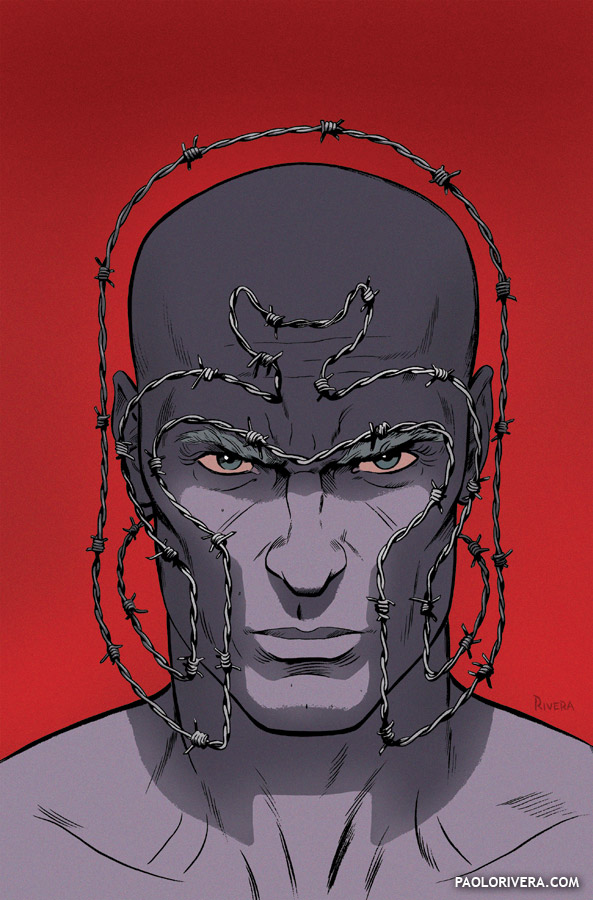 |
| MAGNETO #1 COVER. 2013. Ink(ed by Joe Rivera) on bristol board, 11 × 17″. |
In the last post on inking, I covered the thought process behind inking, but not much of the technical aspects. This post (and the next) will cover my primary tools and why I use them. At the end, you’ll find a time lapse inking video for my Weird Science cover, the process for which I detailed in October.
Ink:
I use Holbein’s Special Black ink, which is waterproof, meaning that once it dries, it’s impervious to water. That allows me to go over it with watercolor if need be. I used to use Pelikan Drawing Ink A, but I stopped after I tried the Holbein. (I also use their products for my paints. You can often catch them at comic convention like San Diego and New York where they offer great discounts — that’s almost exclusively where I do all my shopping.)
I always pour my ink out into a palette cup with an airtight lid. Having a decent-sized opening to dip into will keep your brush clean (and your fingers too). I also like to let it sit for a bit before diving in — fresh ink has a very low viscosity, which means less covering power. I keep a water spritzer close by in case it gets too thick, or I want a wash effect.
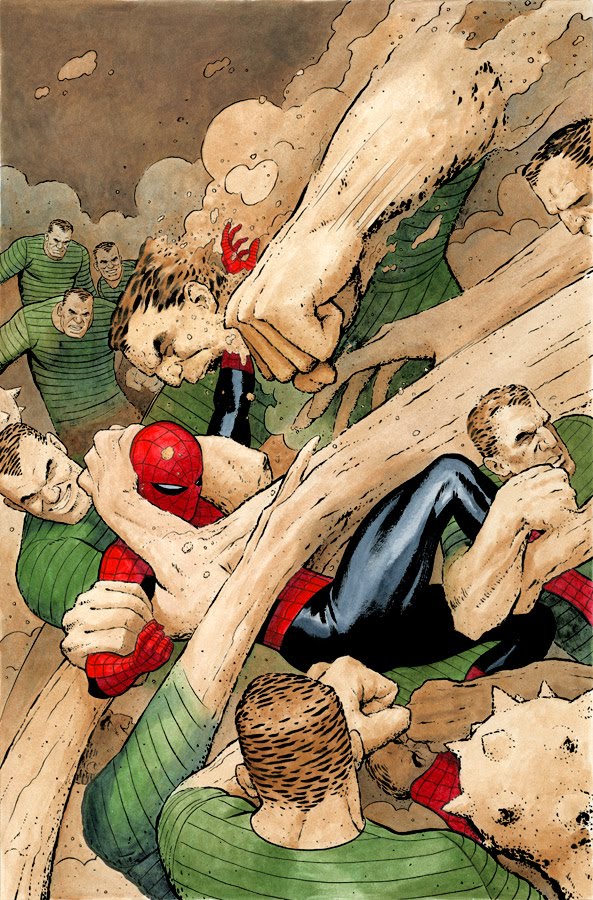 |
| AMAZING SPIDER-MAN #616. 2009. Ink and watercolor on bristol board, 11 × 17.25″. |
White Out:
I use Holbein Titanium White Acryla Gouache, which is an acrylic paint that dries to a matte finish. This is not its intended purpose, but it works really well, especially if you have to go back over it with ink. I use it mostly for special effects and “negative” shapes where it’s easier to paint in white than ink around — stars, wires, leaves, etc.
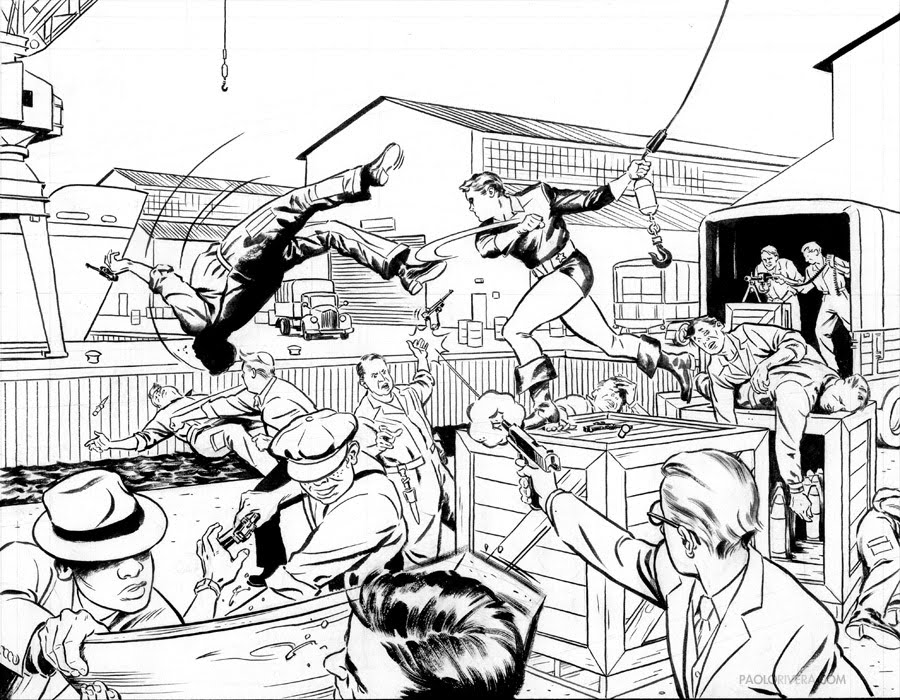 |
| YOUNG ALLIES 70TH ANNIVERSARY SPECIAL #1 PAGE 4, PANEL 1. 2009. Ink on bristol board, 11 × 17″. Step-by-Step |
Paper:
I ink (and draw and paint) on Strathmore 500 Series bristol board, 2-ply with a semi-smooth finish. It’s pre-cut to 11 × 17″ which is standard size for comic art. The 500 Series is ideal because it’s cotton-based, which means it’s more archival and can hold up well to water. I watercolor on this all the time, and sometimes even do more involved gouache techniques.
Brushes:
I use a Winsor & Newton Series 7 #6 brush for most of my inking work. Most people tell me that’s bigger than they prefer, but I wouldn’t have it any other way. A large brush holds more ink and, as a result, can supply consistent marks for an extended period of time. It can cover large areas quickly, or provide as fine of detail as its smallest counterpart. Because the individual hairs are longer, they have more “time” to escape from the ferrule and reconvene at the point. The shorter the hairs get, the greater the chance that a small kink at the base can culminate in a splayed tip.
The whole reason we use brushes is their flexibility. A large brush acts a shock absorber for your hand, smoothing out any stray movements into a flowing line. With a tiny brush, every minuscule tremor, especially at slow speeds, is directly translated (and hence recorded) to the paper.
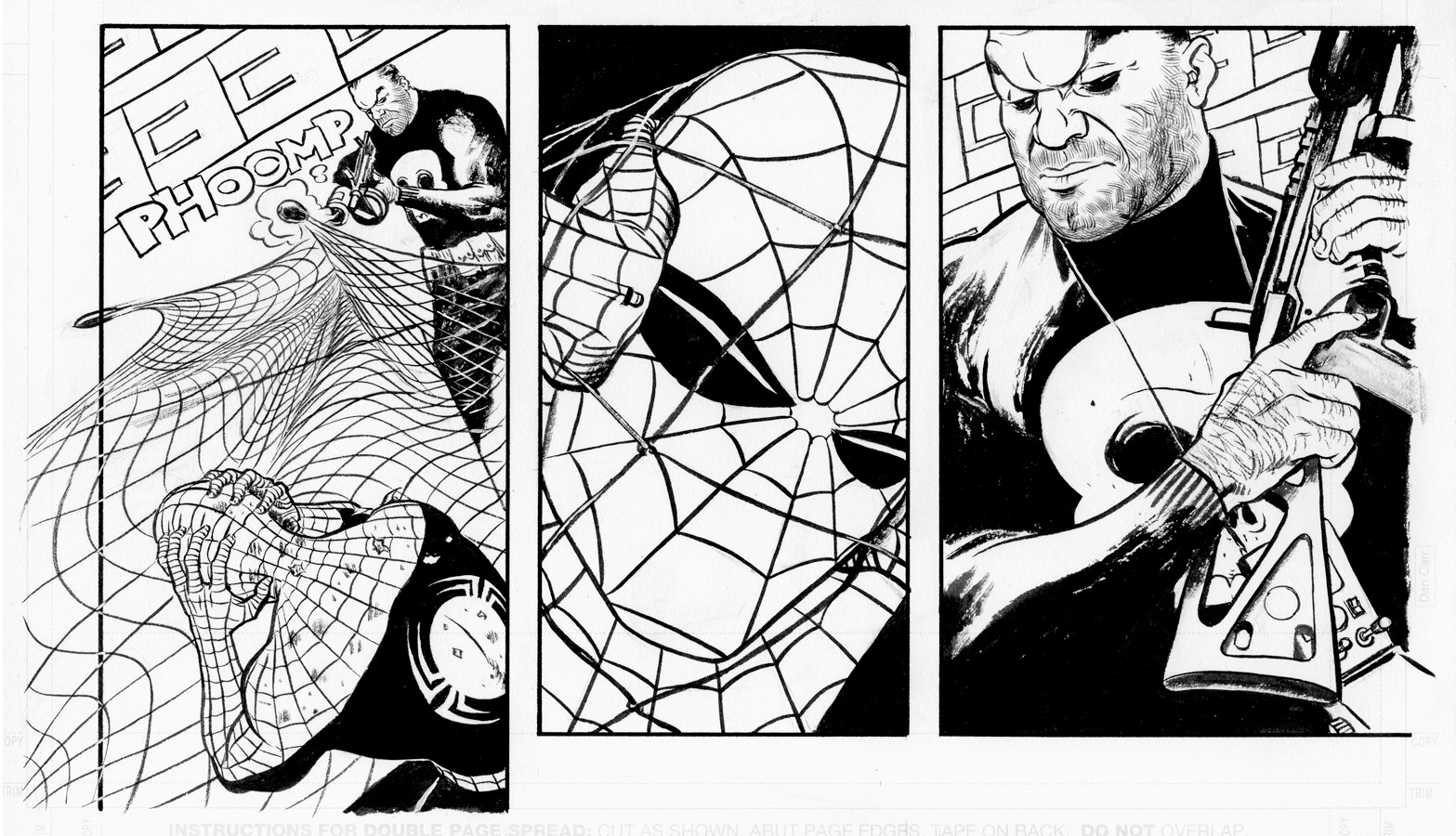 |
| AMAZING SPIDER-MAN #577 PAGE 12, PANELS 4-6. 2008. Ink on bristol board, 11 × 17″. |
All that being said, I do own smaller brushers. I usually keep a #2 or #3 around just in case — this is mostly for lettering, special effects, and lines with little variation in width (I’m looking at you, Spider-Man). I have a #2 brush that I purposefully take piss-poor care of — the ends have splayed out in such a way that I can form a small “rake” that creates 4 tiny, parallel lines — perfect for scruffy beards (now at you, Punisher).
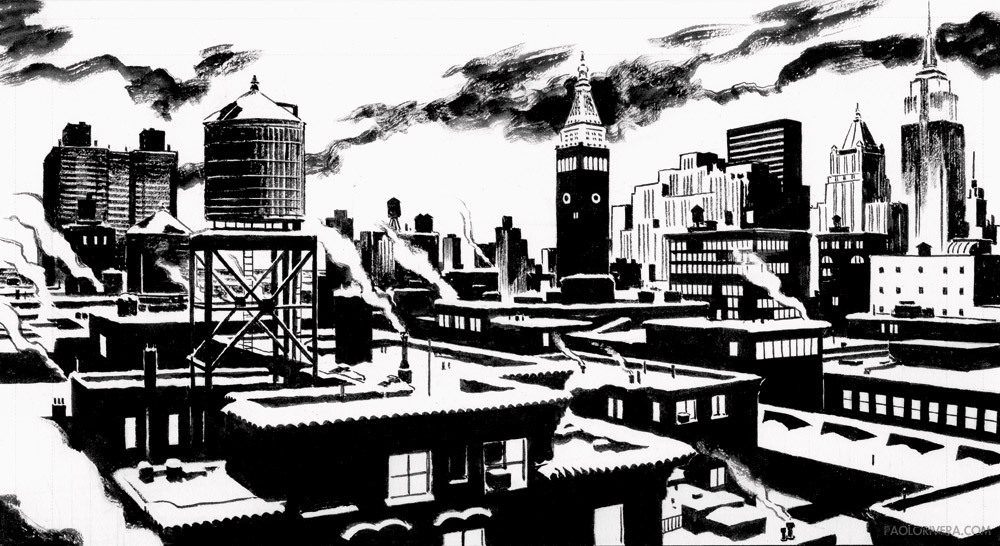 |
| AMAZING SPIDER-MAN #577, PAGE 1, PANEL 1. 2009. Ink on bristol board, 11 × 17″. |
Alternatives:
When I go to comic conventions, much of the day is spent drawing and inking commissions. While I prefer the traditional brush and ink setup, you can’t beat the convenience of a nylon brush with a self-contained ink reservoir. The warm-up sketches below were all done with Pentel’s brush pens. I like them quite a bit, although I have to say that their “gray” is much, much darker than their black. Maybe I just have a defective batch? There are 3 colored brushes in the set (black, gray, and sepia), and an empty one intended for water. I just fill that with Holbein ink and it works just as well as the others. You never have to wash the brush; just put the cap back on.
 |
| WARM-UP SKETCHES (after Jordi Bernet, Alex Raymond, and Moebius). 2013. Ink on paper, 10.5 × 8.25″. |
Brush Washer:
Last, but not least, I find the brush washer to be more important than most people give it credit for. Half of inking well is just loading the brush appropriately. I’ve found that many who shy away from inking with a brush (preferring instead a pen nib) are dipping the brush much too far into the ink well. When I ink, I keep the ink far away from the ferrule which, aside from making the flow easier to control, gives the brush a longer lifespan. My loaded brush is actually on the drier side — I want just enough ink to keep the hairs together, but not so much that it drips. When I touch the brush to the paper, I only want ink to flow when I move.
I have a standard brush washer, but I attached a steel wire that helps me squeeze out all the excess water. I keep a paper towel clipped to it as well. I’m not just drying off my brush; I’m modulating the water content according to the effect I desire. I also keep scrap paper on the drawing board to help shape and test the brush. Above all, you inking demands predictable results, so always test things out until you’re comfortable and confident.
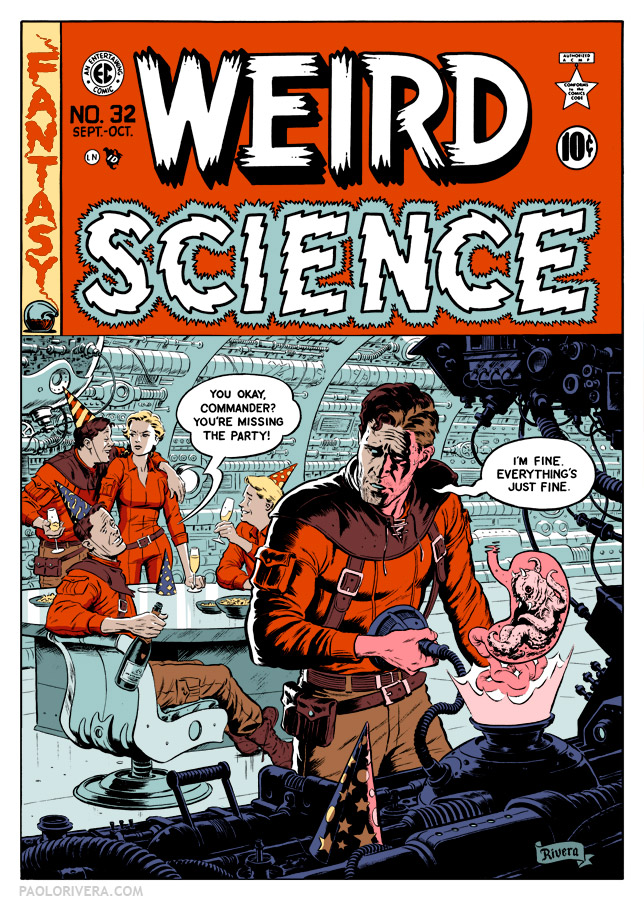 |
|
WEIRD SCIENCE #32 COVER. 2013.
Ink on bristol board with digital color, 13 × 19″.
|


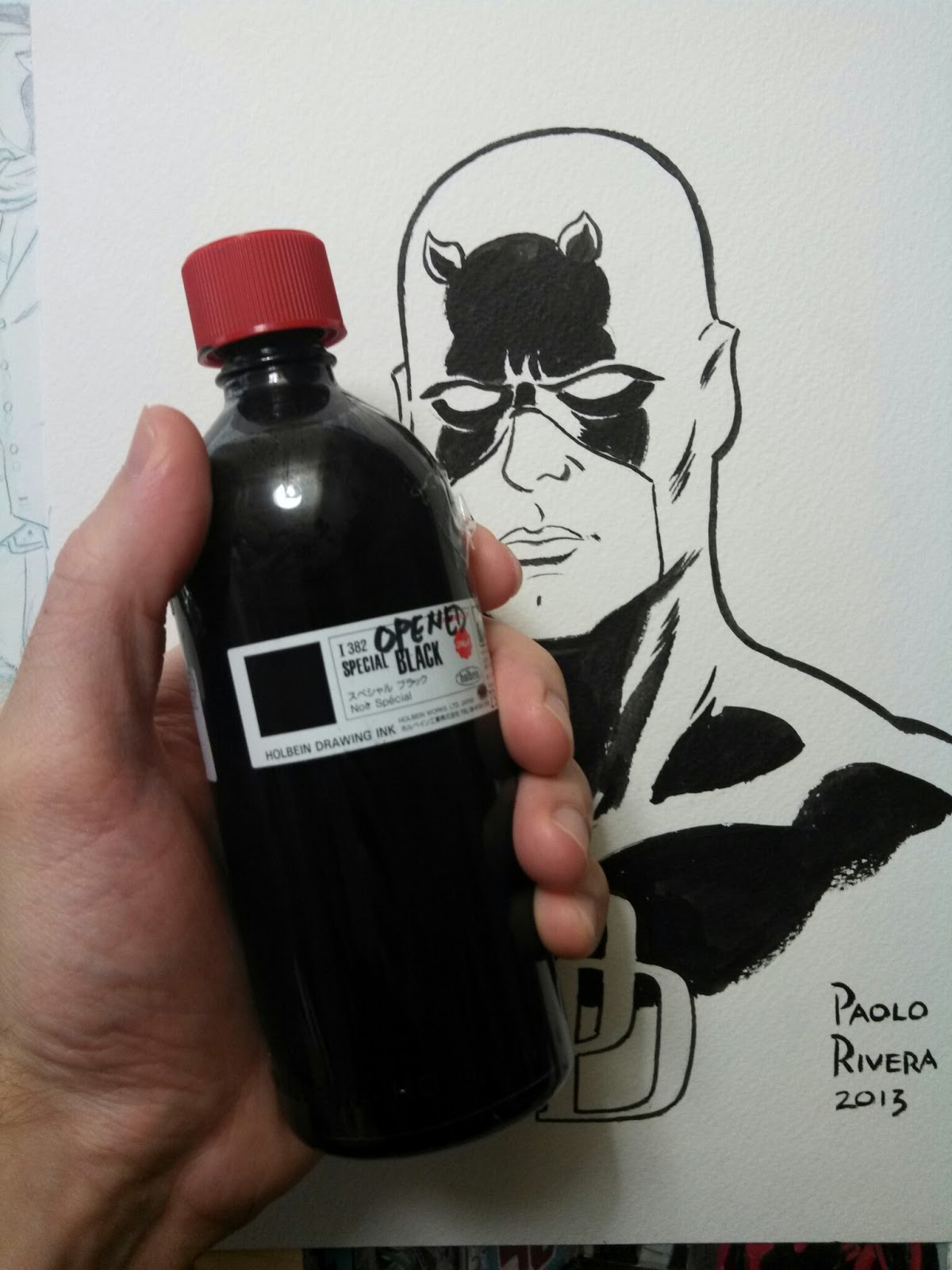

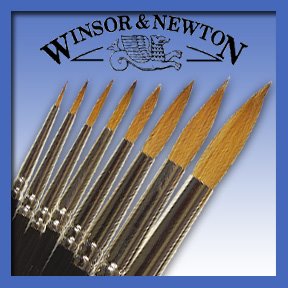

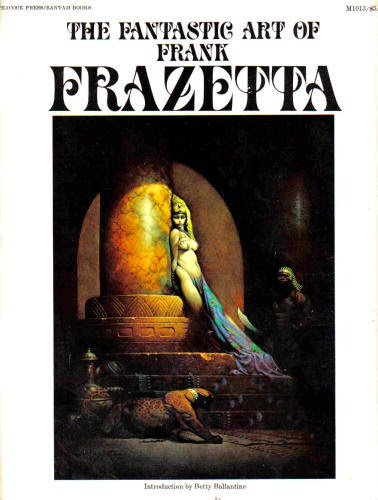
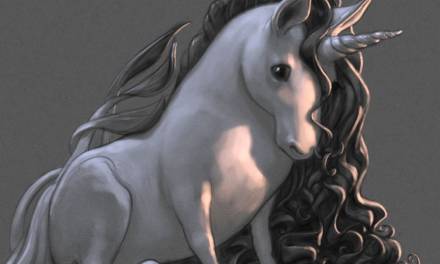
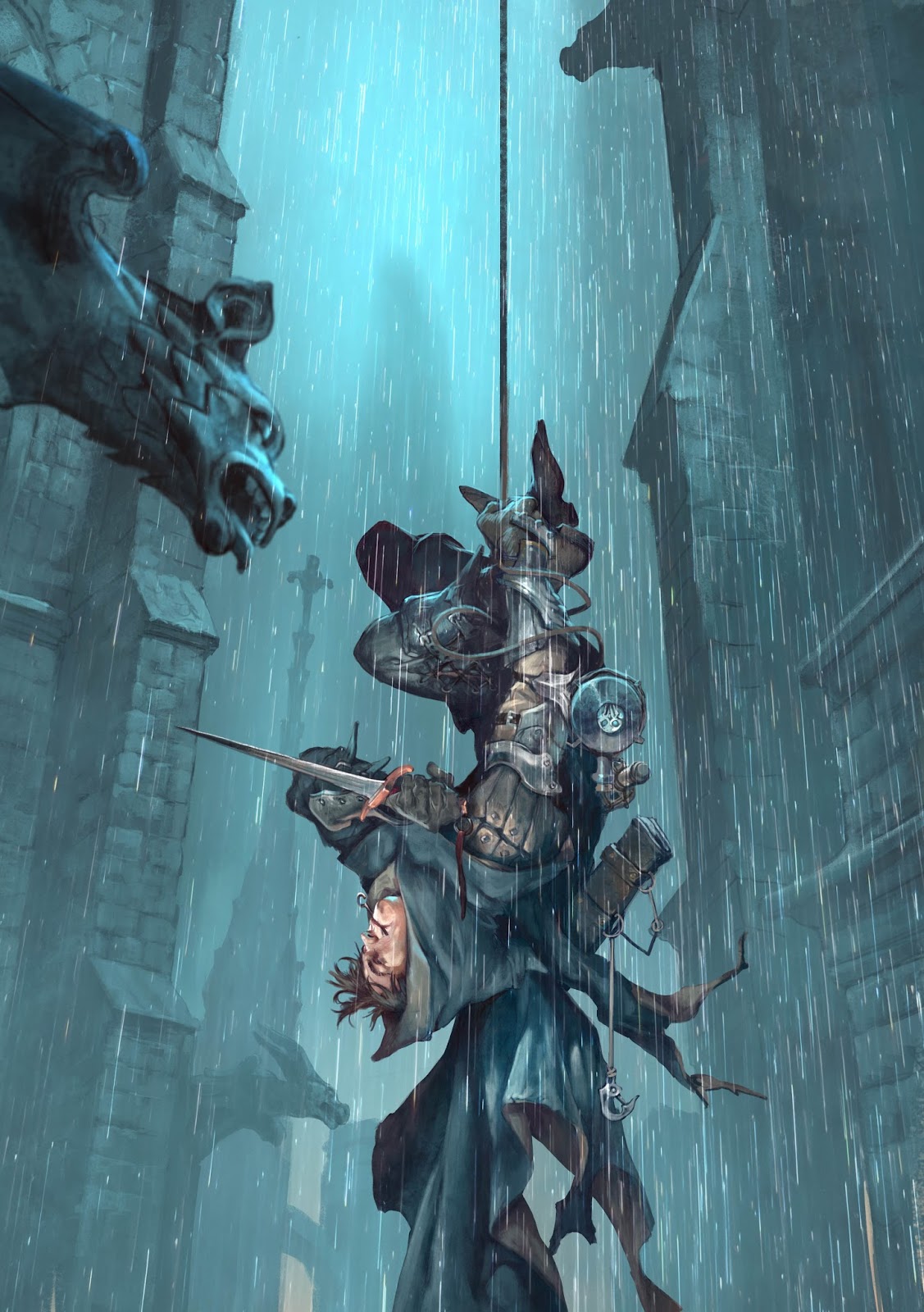
Great post Paolo! I really appreciate all the technical tips. How do you wash your brushes when you are finished for the day?
Paolo, thanks so much for posting this. As someone who's just recently taken some first steps into inking, I found that it was fairly easy to find various recommendations about techniques, but not nearly as much for information on how and where to get hold of the good stuff, and how to use it! Even little tips like pouring the ink into a palette cup helps so much.
This kind of detail is incredibly helpful (and the artwork is amazing and inspiring as usual) – thanks again!
I wash my brushes like I cook my chicken — until juices run clear. I just use regular ol' hand soap and that seems to do the trick. Just make sure to use warm water and work up a good lather.
My pleasure, David! Glad to hear you've found it useful.
I don't have a lot of experience with bristol. When you say “semi-smooth,” is that what Strathmore calls their less smooth “vellum”/cold press? Thanks also for the water-proof black ink recommendation.
The semi-smooth is right in between the vellum surface and the smooth. I pretty much use it for everything now, even gouache painting.
Love it. All of it, but especially the sketchbook “warm-ups”! The AMAZING SPIDER-MAN #577, PAGE 1, PANEL 1, is also incredible. I have a material fetish. Now I have to get some Holbein ink. I have a lots of different inks, even though I don't do much ink work. I keep telling myself that I will. Jetpens.com is a killer for my wallet, but my studio is happier for it. Thanks for the post!
Thanks, Howard! I've been enjoying your posts! And yes, JetPens will be the death of me as well.
Paolo, great stuff. That weird science cover came out wonderfully authentic and your use of larger inking brushes really pays off in keeping everything attractive and un-noodled.
Was interested in that spiderman panel of the rooftop, with all the buildings in silhouette. Are you saying that it was done in smaller brushes? No dip pen, no tech pen, no brush pen? Would love to see a bit more about how you did that one, what the original reference looked like (was it off google? Or your own shots? Or from a tearsheet file?
Anyway, I always enjoy your work and your posts here.
Best,
kev
Thanks, Kev! That panel was probably all done with a #6. It's pretty much the only brush I use. You can see more of the process, along with the reference that went into it, here: http://paolorivera.blogspot.com/2010/05/wacky-reference-wednesdays-no-106.html
Ah, ic. Smart!
thanks again
kev
Oops, got another question. It seems you are printing your blue line digital sketches directly onto bristol board? Are you getting that done at a local print shop or are you doing that in-studio?
That's all done in-studio. I've got an Epson R1900 that prints up to 13×19. It's the same printer I use to make high-quality prints to sell. It's relatively cheap, but the ink's expensive. I've also got a GT-20000 scanner to get everything back in the computer. But my Dad uses a Brother scanner/printer combo that's somewhere around $200.
Thanks so much Paolo. Best wishes to you for a great holiday season.
Paolo, where did you get the large bottle of Holbein ink shown above? I can't find anything but the 1 oz. bottles
It's tough to find. I buy it direct from Holbein at SDCC or NYCC. They might do other conventions, but they're almost always at those two. It's especially worth it because most everything is half off.